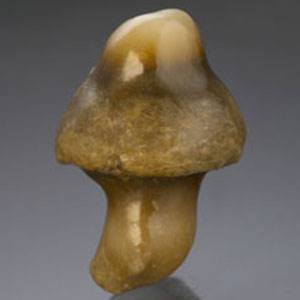|
News
Articles from INDUSTRY ASSOCIATIONS (263 Articles), PEARLS - LOOSE FRESHWATER (41 Articles), PEARLS - LOOSE / TEMPORARILY STRUNG (37 Articles)

The "mushroom pearl" was submitted to the GIA.
‘Mushroom pearl’ submitted for inspection
Posted August 21, 2012 |
A Gemmological Institute of America (GIA) examination laboratory
recently received an unusual pearl, which bore a striking resemblance to
a mushroom.
For centuries, humans have claimed anything from pieces of toast to floor stains have resembled deities and idols. Often in these cases whether someone can see the apparent likeness or not often comes down to personal perception and motivation. However, when the GIA received a pearl that unmistakably resembled a field mushroom, researchers were more focused on determining if it could actually be a legitimate pearl.
Akira Hyatt, a gemologist at the GIA laboratory in New York, studied the pearl, which was recovered near Indonesia, and noticed even more intricate features it had in common with mushrooms.
“The specimen bore an uncanny likeness to a mushroom, consisting of a bell-shaped cap atop a narrower stem,” she wrote in a report for the GIA. “In addition, under the cap we observed arching radial structures very reminiscent of the ‘gills’ found in actual mushrooms. The pearl’s brown color further added to the mushroom effect.”
Digital imaging and microscopic examination further illuminated bizarre attributes including a “mottled growth pattern and coloration” and a “noticeable flame structure at the top of the cap [of the pearl]”.
Further microradiography and spectroscopy tests were performed and proved the curious discovery was indeed a pearl.
“Raman spectroscopy showed an aragonite peak, and EDXRF chemical analysis indicated the presence of Ca, as expected for a pearl,” Hyatt wrote. “The absence of pigment concentrations indicated that the colour was natural. The surface appearance, primarily the intersecting flame structure and liquid inclusions, pointed to a mollusk of the Cassis genus.”
The findings supported the owner of the pearl’s claims it was retrieved from a Cassis cornuta mollusk in the Indoesian archipelago, making the pearl a rarity on two counts.
“While a pearl from a mollusk of the Cassis genus is uncommon in its own right, the shape of this specimen is what made it truly remarkable,” Hyatt added. “Its striking resemblance to a mushroom has not been observed by GIA in any other pearl, from any mollusk species.”
More reading
Backlash to Paspaley pearls
|
|
Search for Industry Associations
|
|